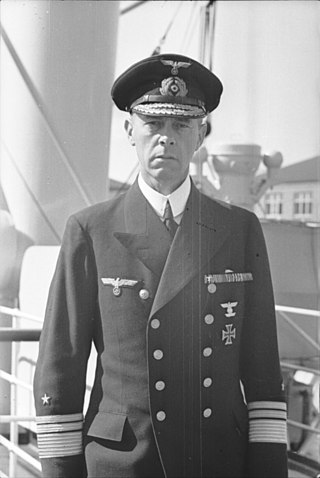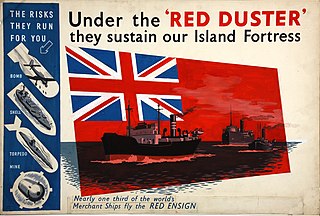
An armed merchantman is a merchant ship equipped with guns, usually for defensive purposes, either by design or after the fact. In the days of sail, piracy and privateers, many merchantmen would be routinely armed, especially those engaging in long distance and high value trade. In more modern times, auxiliary cruisers were used offensively as merchant raiders to disrupt trade chiefly during both World War I and World War II, particularly by Germany.

Operation Rheinübung was the last sortie into the Atlantic by the new German battleship Bismarck and heavy cruiser Prinz Eugen on 18–27 May 1941, during World War II. This operation aimed to block Allied shipping to the United Kingdom as the previously successful Operation Berlin had done. After Bismarck had sunk HMS Hood during the Battle of the Denmark Strait, it culminated with the sinking of the Bismarck, while Prinz Eugen escaped to port in occupied France. From that point on, Germans would rely only on U-boats to wage the Battle of the Atlantic.

USS Pensacola (CL/CA-24) was a cruiser of the United States Navy that was in service from 1929 to 1945. She was the lead ship of the Pensacola class, which the Navy classified as light cruisers in 1929, with the Pensacola herself originally designated as "CL-24." Under the terms of the Washington Naval Treaty, from 1931 on the class was re-classified as heavy cruisers, with the Pensacola being re-designated as "CA-24." The third Navy ship to be named after the city of Pensacola, Florida, she was nicknamed the "Grey Ghost" by Tokyo Rose. She received 13 battle stars for her service.

SMS Moltke was the lead ship of the Moltke-class battlecruisers of the German Imperial Navy, named after the 19th-century German Field Marshal Helmuth von Moltke. Commissioned on 30 September 1911, the ship was the second battlecruiser of the Imperial Navy. Moltke, along with her sister ship Goeben, was an enlarged version of the previous German battlecruiser design, Von der Tann, with increased armor protection and two more main guns in an additional turret. Compared to her British rivals—the Indefatigable class—Moltke and her sister Goeben were significantly larger and better armored.
Thor was an auxiliary cruiser of Nazi Germany's Kriegsmarine in World War II, intended for service as a commerce raider. Also known to the Kriegsmarine as Schiff 10; to the Royal Navy she was Raider E. She was named after the Germanic deity Thor.

Naval warfare in the Mediterranean during World War I took place between the naval forces of the Entente and the Central Powers in the Mediterranean Sea between 1914 and 1918.

The Raid on Scarborough, Hartlepool and Whitby on 16 December 1914 was an attack by the Imperial German Navy on the British ports of Scarborough, Hartlepool, West Hartlepool and Whitby. The bombardments caused hundreds of civilian casualties and resulted in public outrage in Britain against the German Navy for the raid and the Royal Navy for failing to prevent it.

The Thrasher incident, as it became known in US media, was a political and diplomatic incident in 1915, when the United States was still neutral in World War I. On 28 March 1915 the German U-boat U-28 sank the British steamship Falaba by torpedo, killing more than 100 people. One of the victims was a passenger from the US, Leon Chester Thrasher.
The Shelling of Newcastle was conducted by the Japanese submarine I-21 in the early hours of 8 June 1942. The bombardment followed the attack on Sydney Harbour on 31 May, and was conducted shortly after I-24 shelled the Eastern Suburbs of Sydney. During the attack I-21 fired 34 shells at Newcastle, including eight illumination rounds, but caused little damage. The Australian gunners at Fort Scratchley fired four shells at the submarine, but scored no hits.

Defensively equipped merchant ship (DEMS) was an Admiralty Trade Division programme established in June 1939, to arm 5,500 British merchant ships with an adequate defence against enemy submarines and aircraft. The acronym DEMS was used to describe the ships carrying the guns, the guns aboard the ships, the military personnel manning the guns, and the shore establishment supporting the system. This followed a similar World War I program of defensively armed merchant ships (DAMS).

The Bombardment of San Juan, or the First Battle of San Juan, on 12 May 1898 was an engagement between United States Navy warships and the Spanish fortifications of San Juan, Puerto Rico. It was the first major action of the Puerto Rican Campaign during the Spanish–American War.

SM U-21 was a U-boat built for the Imperial German Navy shortly before World War I. The third of four Type U-19-class submarines, these were the first U-boats in German service to be equipped with diesel engines. U-21 was built between 1911 and October 1913 at the Kaiserliche Werft in Danzig. She was armed with four torpedo tubes and a single deck gun; a second gun was added during her career.

The action of 29 February 1916 was a naval engagement fought during the First World War between the United Kingdom and the German Empire. SMS Greif, a German commerce raider, broke out into the North Sea and Admiral Sir John Jellicoe dispatched Royal Navy warships to intercept the raider. Four British vessels intercepted the commerce raider Greif. The armed merchant cruiser RMS Alcantara and Greif fought a brief engagement before British reinforcements arrived when both were severely damaged, both being sunk.

The Second Battle of Durazzo, or the Bombardment of Durazzo was a naval battle fought in the Adriatic Sea during the First World War. A large allied fleet led by the Regia Marina attacked the enemy-held port at Durazzo, Albania. The fleet destroyed the Austro-Hungarian shore defenses and skirmished with a small naval force. Allied forces involved primarily were Italian though British, American and Australian warships also participated. It was the largest naval battle the United States participated in during the war. Most of the city was destroyed in the bombardment.

The bombardment of Cherbourg took place on June 25, 1944, during World War II, when ships from the United States Navy and the British Royal Navy attacked German fortifications in and near the city, firing in support of U.S. Army units that were engaged in the Battle of Cherbourg. In doing so, the Allied naval forces engaged in a series of duels with coastal batteries and provided close support to infantry as they fought to gain control of the city. The bombardment was initially scheduled to last just two hours but it was later extended by an hour to support army units attempting to break into Cherbourg's city streets. After the bombardment, German resistance lasted until June 29, when the port was captured by the Allies. Afterwards, the task of clearing the port for use lasted several weeks.

SMS Augsburg was a Kolberg-class light cruiser of the German Kaiserliche Marine during the First World War. She had three sister ships, SMS Kolberg, Mainz, and Cöln. The ship was built by the Kaiserliche Werft in Kiel; her hull was laid down in 1908 and she was launched in July 1909. Augsburg was commissioned into the High Seas Fleet in October 1910. She was armed with a main battery of twelve 10.5 cm SK L/45 guns and had a top speed of 25.5 knots.

HSwMS Hvalen was a submarine of the Swedish Navy. Constructed in Italy, the submarine sailed the entire way to Sweden for her commissioning unaccompanied. In October 1915 she became involved in a diplomatic incident between neutral Sweden, and Germany, which was then engaged in fighting Britain in the First World War. Following a series of sinkings of German cargo ships and naval vessels in the Baltic Sea by British submarines entering the Baltic through the (Swedish-controlled) Öresund straits, a German warship opened fire on Hvalen killing a crew-member. According to the captain of the Hvalen, she was flying the Swedish naval flag and in Swedish home waters at the time she was fired on. Compensation was later paid to the widow of the crew-member and an apology was issued.
The action of 10 May 1915, or Battle of the Bosporus, was a naval encounter between the Russian pre-dreadnought squadron and the Ottoman battlecruiser Yavuz Sultan Selim in the Black Sea, north of the Bosporus. After a brief exchange of fire the Ottomans withdrew. The battle took place during the main operation of the Black Sea Fleet aimed at shelling the Bosporus fortifications. The action of the battlecruiser led to the interruption of the operation, but it did not manage to inflict significant damage to the Russian fleet, suffering only minor damage itself.
Vice Admiral Hans Viktor Simonsson was a senior Swedish Navy officer. He served as head of the Military Office of the Naval Defence (1933–1938) and as Commanding Admiral of the South Coast Naval District (1938–1942) and of the East Coast Naval District (1942–1945). Simonsson was one of the founders of the Swedish Submarine Service.

The Battle of Funchal on 3 and 16 December 1916 was a series of two attacks by the Imperial German Navy submarine U-38 on the port of Funchal, capital of Madeira during World War I. German sailors succeeded to sink three Allied and one Portuguese ships and also bombarded the city causing several casualties and serious material damage before the Portuguese coastal batteries were able to respond















